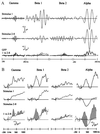Gamma and beta frequency oscillations in response to novel auditory stimuli: A comparison of human electroencephalogram (EEG) data with in vitro models
- PMID: 10852953
- PMCID: PMC16599
- DOI: 10.1073/pnas.120162397
Gamma and beta frequency oscillations in response to novel auditory stimuli: A comparison of human electroencephalogram (EEG) data with in vitro models
Abstract
Investigations using hippocampal slices maintained in vitro have demonstrated that bursts of oscillatory field potentials in the gamma frequency range (30-80 Hz) are followed by a slower oscillation in the beta 1 range (12-20 Hz). In this study, we demonstrate that a comparable gamma-to-beta transition is seen in the human electroencephalogram (EEG) in response to novel auditory stimuli. Correlations between gamma and beta 1 activity revealed a high degree of interdependence of synchronized oscillations in these bands in the human EEG. Evoked (stimulus-locked) gamma oscillations preceded beta 1 oscillations in response to novel stimuli, suggesting that this may be analogous to the gamma-to-beta shift observed in vitro. Beta 1 oscillations were the earliest discriminatory responses to show enhancement to novel stimuli, preceding changes in the broad-band event-related potential (mismatch negativity). Later peaks of induced beta activity over the parietal cortex were always accompanied by an underlying gamma frequency oscillation as seen in vitro. A further analogy between in vitro and human recordings was that both gamma and beta oscillations habituated markedly after the initial novel stimulus presentation.
Figures





Similar articles
-
Comparison of evoked potentials and high-frequency (gamma-band) oscillating potentials in rat auditory cortex.J Neurophysiol. 1995 Jul;74(1):96-112. doi: 10.1152/jn.1995.74.1.96. J Neurophysiol. 1995. PMID: 7472356
-
Auditory event-related response in visual cortex modulates subsequent visual responses in humans.J Neurosci. 2011 May 25;31(21):7729-36. doi: 10.1523/JNEUROSCI.1076-11.2011. J Neurosci. 2011. PMID: 21613485 Free PMC article.
-
A comprehensive analysis of auditory event-related potentials and network oscillations in an NMDA receptor antagonist mouse model using a novel wireless recording technology.Physiol Rep. 2018 Aug;6(16):e13782. doi: 10.14814/phy2.13782. Physiol Rep. 2018. PMID: 30155997 Free PMC article.
-
Sensorimotor and cognitive involvement of the beta-gamma oscillation in the frontal N30 component of somatosensory evoked potentials.Neuropsychologia. 2015 Dec;79(Pt B):215-22. doi: 10.1016/j.neuropsychologia.2015.04.033. Epub 2015 May 19. Neuropsychologia. 2015. PMID: 26002756 Review.
-
High-frequency gamma oscillations and human brain mapping with electrocorticography.Prog Brain Res. 2006;159:275-95. doi: 10.1016/S0079-6123(06)59019-3. Prog Brain Res. 2006. PMID: 17071238 Review.
Cited by
-
Hypotheses relating to the function of the claustrum.Front Integr Neurosci. 2012 Aug 2;6:53. doi: 10.3389/fnint.2012.00053. eCollection 2012. Front Integr Neurosci. 2012. PMID: 22876222 Free PMC article.
-
Speech categorization is better described by induced rather than evoked neural activity.J Acoust Soc Am. 2021 Mar;149(3):1644. doi: 10.1121/10.0003572. J Acoust Soc Am. 2021. PMID: 33765780 Free PMC article.
-
Impacts of Color Coding on Programming Learning in Multimedia Learning: Moving Toward a Multimodal Methodology.Front Psychol. 2021 Dec 3;12:773328. doi: 10.3389/fpsyg.2021.773328. eCollection 2021. Front Psychol. 2021. PMID: 34925175 Free PMC article.
-
The neurophysiology of auditory hallucinations - a historical and contemporary review.Front Psychiatry. 2011 May 16;2:28. doi: 10.3389/fpsyt.2011.00028. eCollection 2011. Front Psychiatry. 2011. PMID: 21629768 Free PMC article.
-
A brain-computer interface for the continuous, real-time monitoring of working memory load in real-world environments.Cogn Neurodyn. 2020 Jun;14(3):301-321. doi: 10.1007/s11571-020-09573-x. Epub 2020 Mar 9. Cogn Neurodyn. 2020. PMID: 32399073 Free PMC article.
References
-
- Barth D S, MacDonald K D. Nature (London) 1996;383:78–81. - PubMed
-
- Roelfsema P R, Engel A K, Konig P, Singer W. Nature (London) 1997;385:157–161. - PubMed
-
- Rodriguez E, George N, Lachaux J P, Martinerie J, Renault B, Varela F J. Nature (London) 1999;397:430–433. - PubMed
-
- Miltner W H, Braun C, Arnold M, Witte H, Taub E. Nature (London) 1999;397:434–436. - PubMed
-
- Gray C M, McCormick D A. Science. 1996;274:109–113. - PubMed
Publication types
MeSH terms
Grants and funding
LinkOut - more resources
Full Text Sources
Other Literature Sources

